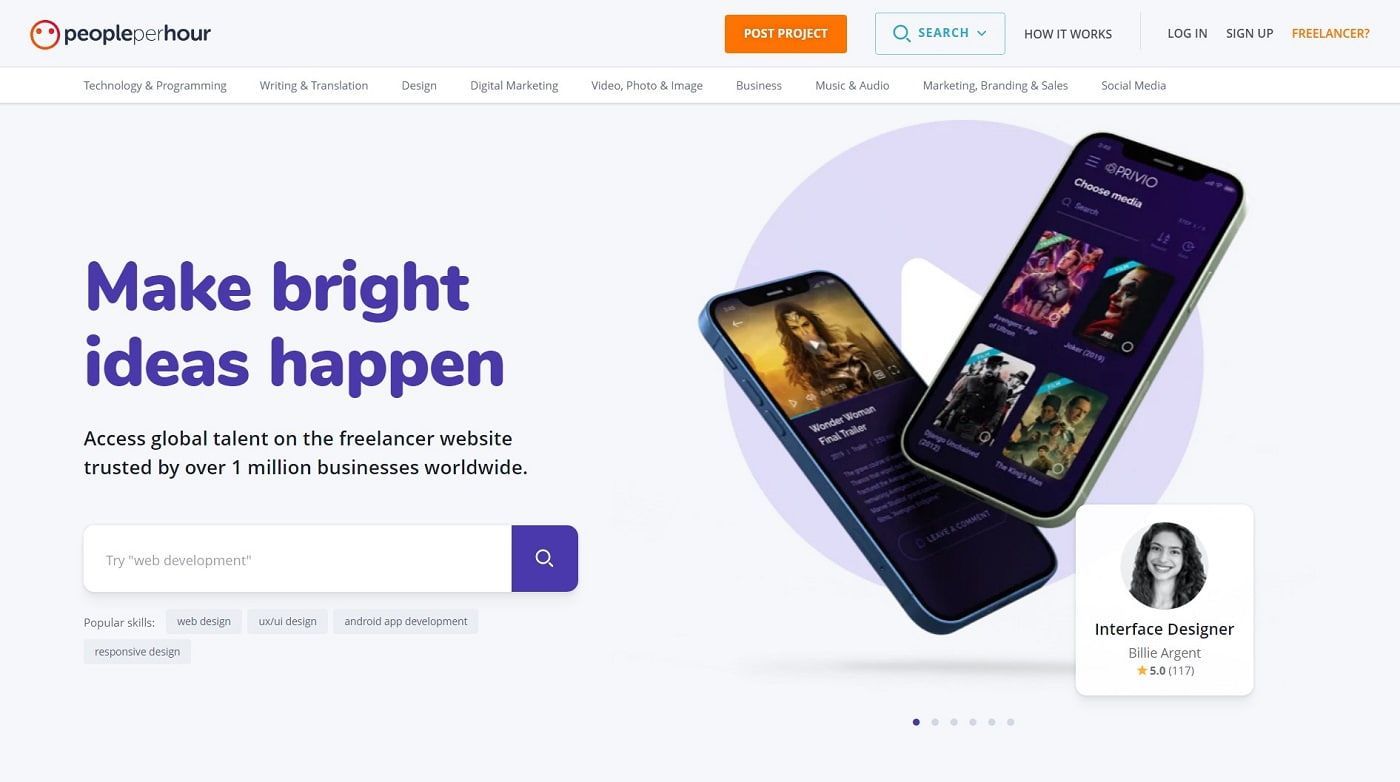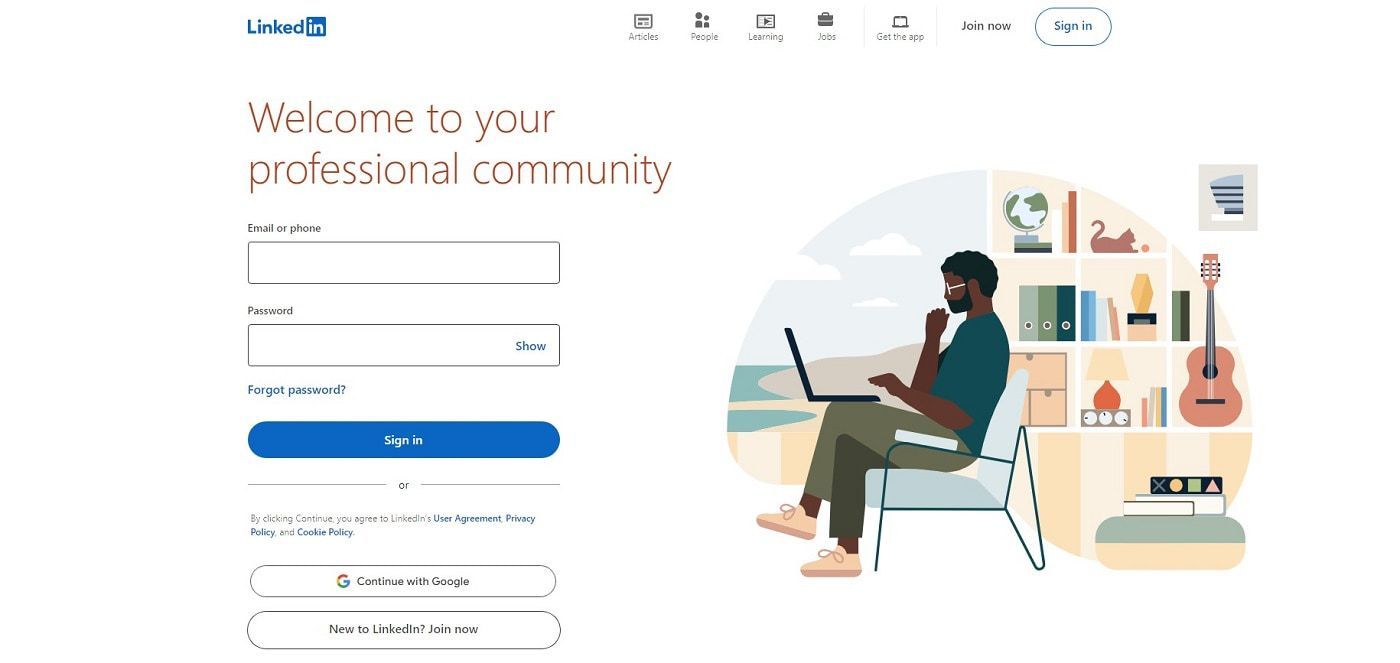Top 10 Best Freelance Websites To Find Work In 2024
By Adrian Mole Updated: Mar 22, 2024

Land ideal gigs and launch your freelance career this year
People have become curious about the best freelance websites to find work as many large companies encouraged employees to work from home since 2020.
However, numerous jobs have been lost in the traditional economy, and finding work is challenging for many people unused to online work.
If you feel that you’re spending too much time chasing work and not enough time doing work, we've found the best freelance websites.
Top 10 Best Freelance Websites to Find Work in 2024
There are hundreds of freelancing websites dedicated to helping you secure online jobs, but finding the ones that are best for you is not easy.
The gig economy's pros and cons make securing jobs on these websites difficult, but successful freelancers know how to market themselves and their skills.
Some freelance websites focus on a particular industry or skill set, helping you secure jobs more quickly with less hassle.
Our list of the 10 best freelance websites for beginners and experienced remote workers will help you find your ideal job postings in 2024.
10. PeoplePerHour

PeoplePerHour is one of the most popular freelance portals for accessing jobs globally, particularly in content writing, logo design, and web development.
With over a million businesses trusting the site and over 3 million rated freelancers available, the gig economy statistics are positive.
Freelancers on PeoplePerHour can apply to become certified contributors, allowing them access to a stream of potential projects tailored to their skill set.
The platform uses an AI algorithm to match freelancers with suitable tasks, also offering the option to create a profile to attract potential clients directly.
Freelancers can apply for projects published directly on the site or create their own unique packages aimed at various different clients.
While there are no registration or signup fees on PeoplePerHour, freelancers are charged a service fee based on the lifetime value of their clients.
The fee structure ranges from 20% for clients billing under $318 over the lifetime of the relationship to as low as 3.5% for clients billing over $6,370.
Between those two fee rates, 7.5% is charged, with a minimum service fee per invoice of just $1.27, excluding VAT.
Pros
- AI-based matchmaking for rapid job matching.
- Various methods for finding and applying for projects.
- Relatively low fees for long-term client relationships.
- It’s a popular destination for creative professionals.
Cons
- Intense competition among more than 3 million freelancers.
- Approval is required to join the freelancer directory.
Bottom Line
PeoplePerHour offers a large variety of global freelance opportunities with an AI-based matchmaking system, although competition may pose a challenge for newcomers.
If you’re a creative professional looking for a service that charges reasonable fees, this website is well worth looking into.
9. DesignHill

DesignHill is a vibrant, creative marketplace catering to businesses seeking quality designs from professional freelance designers and artists.
The focus is on website, brand, and merchandise designs, and it offers a diverse array of graphic designer jobs, including logos, websites, and brochures.
DesignHill opens doors to a wide selection of freelance design jobs, providing an excellent opportunity to enhance your portfolio and cultivate client relationships.
Graphic designers can create their own stores and sell services globally, leveraging tools like the profit calculator and business card maker.
The job portal operates on a client-centric fee model, ensuring freelancers receive the total amount earned from design jobs, contests, or store sales.
Payment withdrawal options include PayPal and Payoneer, which offer freelancers a convenient way to access their earnings at the lowest possible cost.
Pros
- A creative marketplace offering numerous opportunities for freelance designers.
- Engaging design contests and additional earning avenues are available.
- Built-in online store feature.
- No service fees are deducted from freelancer earnings.
- Live chat support for assistance.
Cons
- Limited scope compared to other general gig economy platforms.
- It may not be suitable for non-design freelancers due to specialized focus.
Bottom Line
DesignHill’s vibrant marketplace specializes in creative designs, providing ample opportunities for freelance designers to grow their portfolios with no service fees deducted from earnings.
The online stores make this an attractive option when looking for freelance opportunities, and the Live chat feature is handy.
8. LinkedIn
LinkedIn has become the go-to portal for all manner of freelancers, with professionals from all disciplines represented on the platform.
It is billed as a social media platform for businesses, and it can serve as a digital resume that attracts interested companies.
Everyone with a profile on LinkedIn is there for business, so companies know that the candidates who apply for projects are serious.
Its “Services Marketplace” is where businesses connect with qualified freelancers, and the filtering options make it easy to find suitable candidates.
LinkedIn Services sends project leads directly to freelancers via email, offering ample opportunities to pitch proposals and connect with companies.
LinkedIn offers an effective way to make contact, especially when using the “Open for Offers” option, whether you're looking for remote or part-time gig work.
Pros
- One of the most popular business platforms.
- Extensive professional network.
- Its “Services Marketplace” provides targeted job leads.
Cons
- Competition for job postings is high.
- You may be required to network actively to be successful.
Bottom Line
LinkedIn serves as a professional networking platform connecting freelancers with businesses, offering access to a wide range of freelance opportunities through its Services Marketplace.
To get the most out of this platform, you should enjoy active networking, which is required to stand out amid the growing competition.
7. Freelancer

The biggest gig economy companies use Freelancer to find suitable part-time and work-from-home professionals to fill their roles.
With a global pool of more than 50 million users, Freelancer is trusted by many companies to supply over 1,800 different skill sets.
Whether you plan on fulfilling small projects or sticking around for larger ones, Freelancer will surely have just what you’re looking for.
But, with 80% of jobs posted receiving bids within 60 seconds, it’s a competitive freelance website that isn’t for the fainthearted.
The website provides modules for generating ideas and learning about various subjects, making it ideal for gig economy newcomers.
Employers post a variety of projects of various sizes with multiple payment methods, paying only once the tasks are completed to their satisfaction.
There’s live chat and a dedicated app for easily managing projects, and freelancers can stay in touch with managers and receive job alerts.
Pros
- It is a competitive freelance website with plenty of gigs on offer.
- Suitable for a wide range of freelancers.
- Easy communication.
- Relatively low fees.
Cons
- Intense competition.
- Challenging to stand out from the crowd without “Preferred Freelancer” status.
Bottom Line
Freelancer’s massive user base and diverse job offerings suit freelancers of all skill sets, though the competition may take a little getting used to.
Once you respond to potential clients and build some experience, the active bidding will prove to be a lot less daunting.
6. Guru

Guru caters to a wide range of freelancers from around the world in areas like programming, graphic design, and project management.
This freelance website is easy to use, and creating profiles is a breeze for freelancers who want to advertise their skills to many potential customers.
After you’ve perused the job listings, you send potential clients a bid and wait for a response to your application.
Guru proposes job opportunities to you based on your work experience, skills, and preference for both long- and short-term projects.
The site uses SafePay protection to ensure that you receive timely compensation for your work - without stressing about whether you’ll get paid.
Unfortunately, there are cases in which fake businesses approach users to try and scam them, but doing your due diligence will help prevent problems.
The basic membership for freelancers is free, but Guru does charge you a reasonable 9% fee for completed freelance invoices.
There are paid plans available, costing up to $50 a month, which offer additional tools to expand freelancers' businesses.
Pros
- The large variety of roles.
- Higher rates than similar job portals.
- Less competition than some of the other websites.
- Suitable for beginning freelancers.
Cons
- Paid membership can be expensive.
- The bidding process takes some getting used to.
- Navigation of the massive job library is initially challenging.
Bottom Line
Guru provides an easy-to-use platform for freelancers to display their skills and bid on projects, offering a range of job opportunities with built-in payment protection.
However, navigating the bidding process and the higher membership costs may require some adjustment before you start to see noteworthy results.
5. SimplyHired

Freelancers and remote workers are drawn to SimplyHired for its ease of use and large variety of human resources, finance, and data entry jobs.
When searching for a job, you can narrow down your search by entering relevant keywords as well as including your preferred location.
Freelancers also have access to information about the company's advertising on the website, with an overview of the company and employee reviews.
You don’t need an account with SimplyHired to access the jobs, but it does help if you need assistance in creating your resume.
Site members can access the resume builder as well as a variety of employment tools, including a helpful salary estimator.
Pros
- Job searches are easy and intuitive.
- A wide variety of the best gig economy jobs are available.
- No account or signup is required to apply for jobs.
- Email alerts are available.
- The website includes guides and free job tools.
Cons
- Highly competitive.
- Not all the jobs involve remote work.
Bottom Line
SimplyHired offers an intuitive job search experience with a wide variety of remote opportunities, though the high level of competition is disconcerting at first.
The non-remote job listings may be limiting factors for some freelancers but may offer attractive alternatives to working from home only.
4. FlexJobs

FlexJobs has been around since 2007, and it has an excellent reputation for weeding out dodgy freelance and remote job offers.
Freelancers must sign up for a subscription that costs $2.95 for a 14-day trial, which rebills at a hefty $23.95 fee every four weeks thereafter.
Despite the cost, sites like FlexJobs have recorded almost 11,200 reviews and received an average of 4.5 out of 5 stars from users.
It is gig economy statistics like these that prove that traditional jobs are not the only way to earn a living in the digital age.
The site focuses on remote job listings in a multitude of categories, from accounting and project management to sales and freelance writers.
Their excellent search feature allows remote workers to search for jobs by type of work, industry, work schedule, level, and status.
This means that you can search for part-time or full-time work at an entry-level or executive position in startups or Fortune 500 companies.
Pros
- All jobs are vetted by in-house staff.
- Staff are on hand to assist with guiding your job search.
- Resources are available to improve your chances of being hired.
- A wide range of job opportunities.
Cons
- The monthly subscription is high.
- Competition for better-paying jobs is fierce.
Bottom Line
FlexJobs is famous for its curated job listings and reputation for weeding out unreliable opportunities, though the monthly subscription fee may put off some freelancers.
While competition for premium jobs may deter some freelancers, there are plenty of opportunities if you take the time to look carefully and stay consistent.
3. Toptal

Toptal is one of the most exclusive freelancing websites, and it caters only to the very best independent contractors in the gig economy space.
You’ll find that the positions advertised on the platform are primarily high-end, and you’ll have to undergo a rigorous screening process.
Fortune 500 companies like Microsoft and Salesforce recruit top talent here, so you’ll have to bring your A-game to succeed.
If you are a freelance writer, developer, designer, financial expert, project manager, or product manager with plenty of experience, then Toptal is for you.
Beginners or those new to their field may find it hard to sell their services on Toptal as the competition is very high.
Pros
- You keep 100% of your earnings – Toptal doesn’t charge you a fee.
- High-quality clients pay premium rates.
- Excellent opportunity to work on groundbreaking projects.
- Flexible work schedule.
Cons
- A rigorous vetting process makes it hard to get accepted.
- A very competitive environment that makes it difficult to win projects.
- Not suitable for new freelancers.
Bottom Line
Toptal caters to top-tier freelancers with exclusive job listings from reputable companies and offers premium rates and flexibility to experienced candidates.
Though the rigorous screening process and high competition may present some challenges for newcomers, the rewards are worth the trouble.
2. Fiverr

Fiverr, one of the best freelance job sites, provides a convenient platform for business owners who require digital services.
It is the go-to marketplace for content writing jobs and web design but has expanded to cover many gig economy offers in the digital space.
Freelancers, called "sellers," set up gigs in various categories that business owners, referred to as "buyers," can purchase at various prices.
Set Your Own Rates
Sellers set their own rates for the freelance jobs they offer, with $5 being the lowest, and raise prices incrementally for additional services and features.
Once a gig is ordered, Fiverr charges the buyer and holds on to the cash until the service is delivered and the gig is approved.
Fiverr takes a 20% fee off the amount due to the seller and transfers the money to their account for withdrawal later.
Sellers have a few options to collect their cash, either through a Fiverr Revenue Card (debit card), direct deposit, PayPal, or Payoneer.
Optimize Your Profile
To improve your chances of getting hired, optimize your profile and gigs using keywords to raise your visibility on the platform.
You must showcase your skills with a portfolio that stands out, so buyers can see that you provide high-quality work.
When you sell a gig, ensure that you provide 5-star value so that your rating on Fiverr acts as a selling point for future buyers.
Freelancers can also offer additional services, such as unlimited revisions, faster delivery times, or money-back guarantees, to further stand out from the crowd.
Pros
- Registration is free.
- The setup is simple.
- Many job categories.
- You don’t have to actively sell your services – buyers come to you.
Cons
- Fiverr takes 20% of your earnings.
- There’s a lot of competition.
- It takes a while to receive your payments.
Bottom Line
Unlike most client-centered job portals, Fiverr provides a convenient platform for freelancers to offer digital services with flexible pricing options.
Though the platform's commission fees and competitive environment require strategic optimization to succeed, it offers many lucrative opportunities for new and experienced freelancers.
1. Upwork

Upwork connects independent workers from around the world with a wide range of clients who require experienced and skilled talent.
Small- and medium-sized businesses looking for skilled freelancers can post their jobs or gigs on the website across various job categories.
Whether you are engaged in software development and IT, AI services, or design and creative, numerous positions are waiting to be filled.
But it doesn't stop there if you're a skilled freelance writer, sales and marketing professional, or translator - you're in great demand.
Admin And Customer Support Gigs
Many companies also require admin and customer support personnel, two job categories uniquely suited to remote work.
With software like QuickBooks and Xero offering cloud-based finance and accounting, many businesses hire home-based staff.
The built environment is another industry suited to remote work, with plenty of jobs available in engineering and architecture.
Create An Enticing Profile
To take advantage of gig economy trends, you need to create a profile that shows off your education, experience, and skills.
Then, you can either apply directly for freelance jobs posted on the website or wait for companies to discover you through the search feature.
To help you win more jobs, Upwork offers Freelancer Plus, a monthly subscription to help you market yourself more effectively.
It costs $20 per month and helps you market your services more effectively, submit proposals, and stand out from the crowd.
You Need Connects
To apply for jobs on Upwork, you need to pay in "connects," which are tokens that are applied in various amounts, depending on the job.
You get 10 connects with a free account, and you must buy additional tokens at $0.15 each if you wish to apply for more jobs.
Upgrading to the Freelancer Plus plan offers 100 connects per month and the option to see competitors' bids, so you can win jobs.
Pros
- It is a well-known and trusted job portal with a solid reputation.
- You are paid in various ways, including direct deposits, wire transfers, Instant Pay, PayPal, Payoneer, and M-Pesa.
- Hourly contracts are billed weekly, while fixed-price contracts are paid after reaching certain milestones.
- Excellent job search feature lets you find exactly what you're looking for.
- Payment protection for freelancers and clients.
Cons
- The vetting process for gig workers is long and very selective.
- You pay a service fee of 10% on all freelance jobs.
- A high number of freelancers means competition is fierce.
Bottom Line
Upwork is a mature and trusted platform that connects freelancers with a diverse array of job opportunities and supports multiple payment methods.
However, the competitive marketplace and service fees necessitate proactive self-marketing and strategic budgeting for connects to gain the full benefit of this established job portal.
Summary
The best freelance websites that we’ve listed here are some of the most trusted job portals on the internet, having stood the test of time.
They each enjoy millions of visits per month, with millions of freelancers relying on them to provide honest and verifiable work.
While the fees on some top freelance websites may appear high, the chances of selling your services are worth the cost in the long run.
Adrian Mole is a UK-based Chartered Accountant and Chartered Tax Adviser. With a career spanning over 30 years, he has advised clients of all sizes on accounting, business, and tax matters and has a passion for helping startups. Formerly a partner of a Top Ten accounting firm in London, he now runs a small accounting practice closer to home with a committed team of finance professionals. A private pilot and keen scuba diver, when not working, he enjoys time with his family and teaching Ballroom dancing.
– Recommended Reads –
The information found on this website is for general purposes only and should not be considered financial advice. The Positive Accountant is an opinion and information based website only. Please do your own research and consult with a qualified professional before making any financial decisions.





